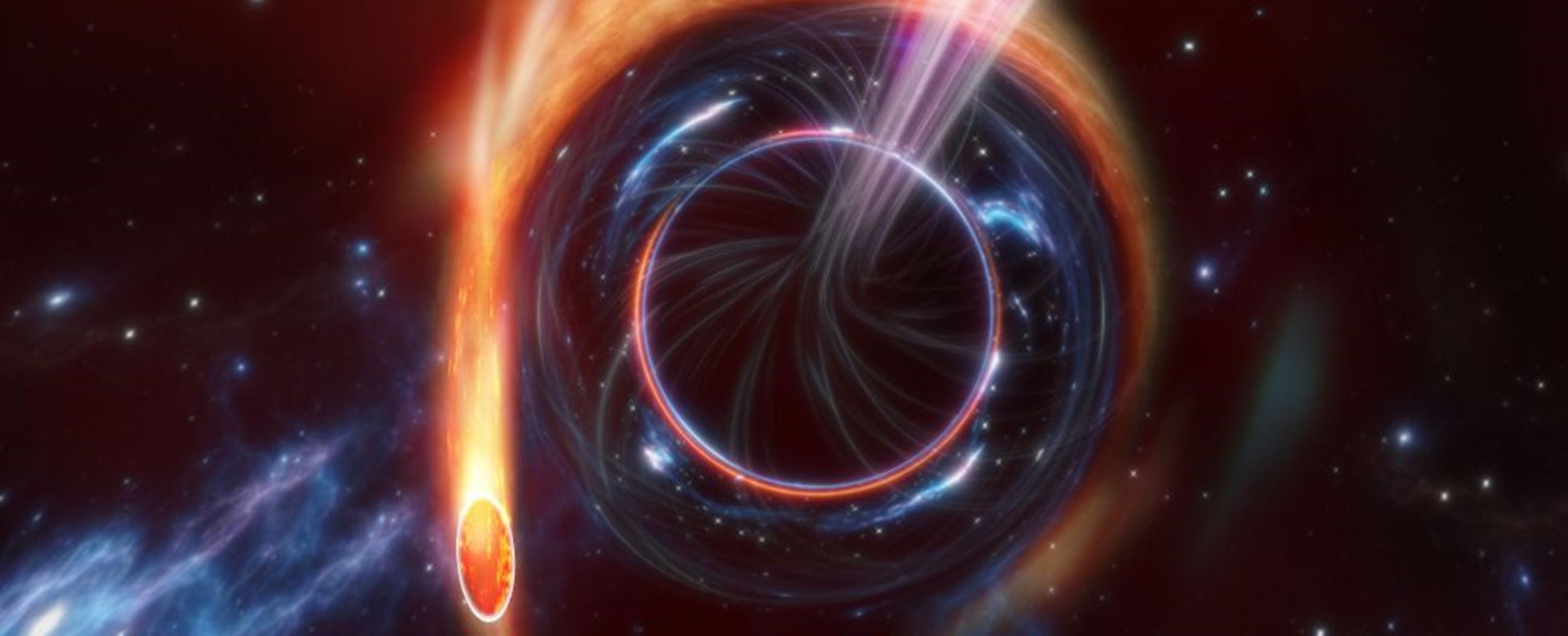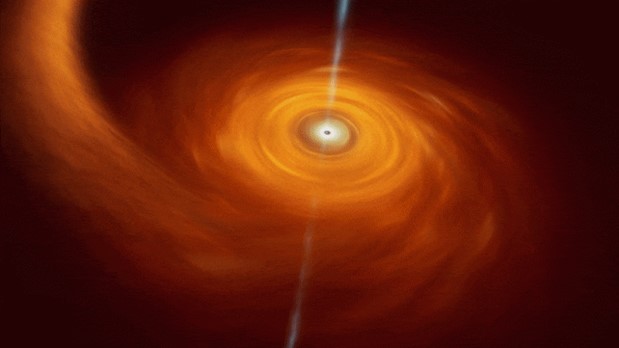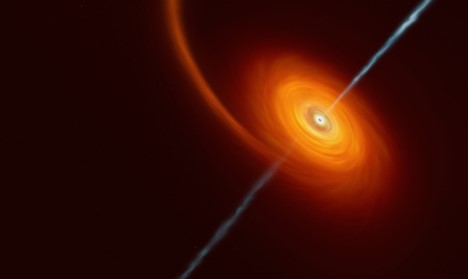by Rida Fatima
The final breath of a dying star before it was engulfed by a black hole was the light that traversed over 8.5 billion years before reaching the Earth.

(Figure 1: An example of a black hole damaging a star due to tides. (Carl Knox, OzGrav, Swinburne University of Technology’s ARC Center of Excellence for Gravitational Wave Discovery))
Two different groups of researchers came to the conclusion that AT2022cmc, a mystery glint in the darkness of space in February 2022, was the cosmological stream that blasted from the huge black hole as the shattered star fled outside its event horizon.
Since AT2022cmc is currently the farthest object we have observed, it is quite unusual that we witness one of such events in progress. The two publications were released in Nature and Nature Astronomy, respectively. Michael Coughlin, an astronomer at the University of Minnesota Twin Cities in the United States, said:
“The last time scientists discovered one of these jets was well over a decade ago. From the data we have, we can estimate that relativistic jets are launched in only 1 percent of these destructive events, making AT2022cmc an extremely rare occurrence. In fact, the luminous flash from the event is among the brightest ever observed.”
In our chaotic cosmos, there is a great deal of phenomena happening. Many of these occurrences and happenings, such as supernova explosions, rapid radio wave bursts, stars colliding, interplay between compact binaries, and black hole feeding frenzy, are unreliable, spewing out transient flashes of light that blaze across the the depths of space before dissipating.
We can only observe vast areas of the cosmos carefully in order to see the illumination from such enormous but fleeting astronomical phenomena.

(Figure 2: This graphic depicts how a star’s components descended into a faraway galaxy’s black hole, creating streams of debris and energy in the process. The incident, known as AT2022cmc, might be observed for the first time from Earth using an optical telescope since the jets are virtually aimed at us. Credit: M. Kornmesser/ESO)
In the previous year, a surveying telescope noticed an unexpected concentration of light waves and contacted the European Southern Observatory’s Very Large Telescope (ESO’s VLT). The VLT as well as additional telescopes were quickly oriented towards to the origin, which was a supermassive black hole in a far-off galaxy that had sucked up a star and ejected the remains in a jet. The VLT found that it was the farthest instance of a similar occurrence that had ever been seen. This additionally marks the first time the jet has been observed using visible light, opening up a new method of seeing these extreme events because the jet is virtually pointed directly at us.
A tidal disruption event (TDE) takes place when stars approach a black hole too closely and are shattered by the black hole’s powerful tidal forces. About 1% of such events result in the revolving black hole’s polarities ejecting plasma and energy in the form of jets. John Wheeler, a pioneer of black holes, presented the principle of jetted-TDEs as:
“A tube of toothpaste gripped tight about its middle, causing the system to squirt matter out of both ends.”

(Figure 3: This creator’s rendering shows what it would appear like when a star comes too close to a black hole and is crushed by its powerful gravitational attraction. The ring that is visible in this picture is formed when a portion of the star’s debris is drawn in and begins to spiral all around black hole. Streams of material and energy can occasionally be seen shooting out from the black hole’s edges, as in this instance. Several telescopes, including the VLT, observed signs of the streams in the instance of the AT2022cmc occurrence, and this was found to be the farthest instance of a similar incident. Credit: M. Kornmesser/ESO)
Nial Tanvir, who headed the investigations to gauge the entity’s proximity using the VLT, from the University of Leicester in the UK, elaborated:
“We have only seen a handful of these jetted-TDEs and they remain very exotic and poorly understood events”
To learn how the jets are truly formed and why only a limited percentage of TDEs generate them, researchers are therefore continually searching for such intense occurrences.
In order to fulfill this mission, numerous telescopes, like the Zwicky Transient Facility (ZTF) in the US, frequently scan the cosmos for indications of brief, frequently severe occurrences that might later be examined in considerable depth by other telescopes, like the ESO’s VLT in Chile. Igor Andreoni, an astronomer at the University of Maryland in the US, and Michael Coughlin, an astronomer at the University of Minnesota, co-led the research that was released recently in Nature. The researchers stated:
“We developed an open-source data pipeline to store and mine important information from the ZTF survey and alert us about atypical events in real time”
An unexpected origin of visible light was discovered by the ZTF in February last year. The incident, designated AT2022cmc, resembled a gamma-ray burst, the known universe’s most intense source of radiation. Researchers activated numerous telescopes from all over the world to look closer at the enigmatic object in anticipation of seeing this unusual occurrence. Within this was ESO’s VLT that swiftly used the X-shooter equipment to investigate this novel occurrence. The light emitted by AT2022cmc started its voyage when the universe was roughly one-third of its present age, according to the VLT measurements, which put the origin at an unheard-of distance for such occurrences.
The scientists analyzed this information with various known events, such as kilonovae and collapsing supernovae. However, the information merely supported the possibility of an unusual jetted-TDE heading in our direction. Co-author of this work and astronomer Giorgos Leloudas from DTU Space in Denmark says:
“Because the relativistic jet is pointing at us, it makes the event much brighter than it would otherwise appear, and visible over a broader span of the electromagnetic spectrum.”
AT2022cmc was revealed as the most remote TDE currently identified by the Wohl distance measurement, yet this is not the sole record-breaking feature of this entity. Co-author of the paper and astronomer at Liverpool John Moores University in the UK, Daniel Perley, states:
“Until now, the small number of jetted-TDEs that are known were initially detected using high energy gamma-ray and X-ray telescopes, but this was the first discovery of one during an optical survey”
This shows a novel method for identifying jetted-TDEs, enabling future research into such unusual occurrences and exploration of the harsh conditions near black holes.
References
- Andreoni, I., Coughlin, M.W., Perley, D.A. et al. A very luminous jet from the disruption of a star by a massive black hole. Nature 612, 430–434 (2022). https://doi.org/10.1038/s41586-022-05465-8
- Rees, M. J. Tidal disruption of stars by black holes of 106–108 solar masses in nearby galaxies. Nature 333, 523–528 (1988).
